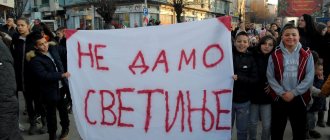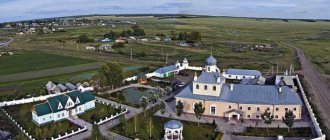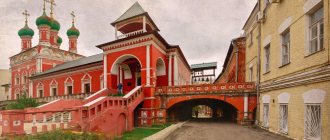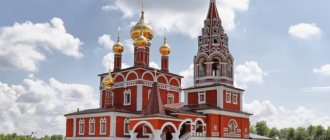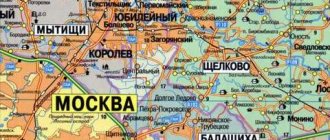| Metropolitan Manuil (Lemeshevsky) |
Manuil (Lemeshevsky)
(1884 - 1968), Metropolitan b. Kuibyshevsky and Syzransky In the world Lemeshevsky Viktor Viktorovich, born on April 18, 1884 in the city of Luga, St. Petersburg province. His ancestors belonged to a hereditary noble family and were distinguished by their religiosity.
He received his education at the Libau Nikolaev Classical Gymnasium (now the city of Liepaja, Latvia), from where he graduated in 1903. Then he studied at St. Petersburg University at the Faculty of Law; in 1910 he left his final year (in 1920 he entered the university again). He graduated from higher library courses in Leningrad in 1919-1920.
In 1906 he was elected a member of the Russian Bibliographical Society and remained a member until 1917. He developed a plan for the establishment of the Russian Bibliographic Institute.
He began his spiritual service in April 1910 in the Nikolo-Stolpenskaya hermitage of the Tver diocese.
On June 2, 1911, he was tonsured a monk, and on December 10 of the same year he was elevated to the rank of hierodeacon.
On September 16, 1912, he was ordained hieromonk in the city of Semipalatinsk.
From August 1912 to August 1916 - assistant to the head of the Kyrgyz spiritual mission of the Omsk diocese in the city of Semipalatinsk.
In 1916 he entered the Petrograd Theological Academy.
Since 1917 - assistant librarian of the Petrograd diocese.
In the summer of 1917, he was secretary at the pre-congress meeting of learned monasticism.
In August 1918, he was on a scientific trip to the Olonets diocese to examine and describe monuments of local church antiquity.
From April (approved on September 20) 1919 - rector of the St. Nicholas (house) church on Spasskaya Street near Liteiny Prospekt of the Alexander Nevsky Society of Temperance (closed in April 1923). In March 1920, he founded the Spassky Brotherhood under her.
On August 5, 1919, he was appointed rector of the Holy Trinity St. Sergius Hermitage near Leningrad.
| Archbishop Manuil (Lemeshevsky) |
Since 1919, he worked as a senior librarian at the All-Russian Central Pedagogical Museum of the Main Professional Education Department of the People's Commissariat of Education of the RSFSR.
From 1921 to 1923 he taught the Holy Scriptures of the Old Testament at theological pastoral courses in the city of Petrograd.
Arrested on June 16, 1922. He did not remain under arrest for long.
On September 8, 1923, in the Danilov Monastery in Moscow, his former abbot, Bishop Theodore (Pozdeevsky), was elevated to the rank of archimandrite.
The naming of Bishop of Luga, vicar of the Petrograd diocese, was made by Patriarch Saint Tikhon in the presence of members of the Holy Synod and visiting bishops, numbering more than thirty people, in the St. Michael's Church of the Donskoy Monastery. On September 23, 1923, his episcopal ordination took place in the Moscow Church of St. Demetrius of Thessalonica on Blagush. At the same time he was appointed manager of the Petrograd diocese until February 1924. The consecration was performed by Patriarch Tikhon, Archbishop Hilarion of Vereya, Sebastian of Kostroma and Bishop Hierotheus, who soon went into the Josephite schism.
It is known about the friendship of Bishop Manuel with the Venerable Seraphim of Vyritsky, who was then in the Alexander Nevsky Lavra [1].
He was arrested again on February 3, 1924, on charges of organizing an illegal fraternity. Sentenced to 3 years in concentration camps. He served time in Solovki. By a resolution of a special meeting at the OGPU board of September 16, 1927, upon completion of his sentence, he was deprived of the right to reside in 6 central provinces and the border strip for a period of 3 years. By a decree of March 9, 1928, this decision was canceled.
In February 1928 he arrived in Moscow.
From May 8 or 11, 1928 - Bishop of Serpukhov, vicar of the Moscow diocese. From May 11 to 15 of the same year he was in Leningrad to testify to the believing people their support for Metropolitan Sergius (Stragorodsky) and their rejection of the Josephite division.
Since October 1929, he has also been temporarily managing the Kashira Vicariate, which is why it is called Serpukhov and Kashira.
On January 30, 1930, he submitted his resignation letter. The report was accepted. From January 31 of the same year he did not govern the diocese.
He was arrested on January 31, 1930, in January 1932, at the end of 1931 until May 1932, the bishop was in solitary confinement. On December 20, 1933, he was arrested again and sent to Mariinsk, Novosibirsk region, where he stayed until the spring of 1936. Then he spent several years wandering, until on April 18, 1939 he was arrested again and sent to Kansk, where he stayed for four years.
In the fall of 1944 he was released.
From November 1944 to February 14, 1945, he was at the disposal of the Archbishop of Tambov, Confessor Luke, who warmly received him and allowed him, a bishop without a pulpit, to perform the ceremony in the cathedral. He was summoned to the Local Council of the Russian Orthodox Church at the beginning of 1945, but could not arrive on time due to snow drifts.
Since February 14, 1945 - Bishop of Chkalovsky. In 1946, his work began on a fundamental catalog of Russian bishops.
On Easter April 21, 1946, he was elevated to the rank of archbishop.
Arrested on September 4, 1948 and on April 16, 1949, sentenced to a ten-year term and exiled to the Potem camps (Yavase) of the Mordovian Autonomous Soviet Socialist Republic. Released in December 1955, rehabilitated in 1956.
On December 21, 1955, he was appointed administrator of the Cheboksary-Chuvash diocese, and on February 7, 1956 he was confirmed as Archbishop of Cheboksary and Chuvashia.
Since 1960 - candidate of theology.
Since March 22, 1960 - Archbishop of Kuibyshev and Syzran.
On February 25, 1962 he was elevated to the rank of metropolitan.
On November 25, 1965, he was retired, according to the petition, due to illness, with the right to serve and with a stay in the city of Kuibyshev (now Samara).
He died on August 12, 1968 in Kuibyshev. He was buried in the vestibule of the Samara Intercession Cathedral.
Along with diocesan affairs, the bishop was enthusiastically engaged in literary activities, primarily on his collection “ Russian Orthodox Hierarchs”
." Knowledge of theological literature, combined with an excellent memory, helped him in historical research in all areas of church history, and even more so in studying the life and deeds of bishops. In his cell there were boxes with thousands of cards containing information on church history, hagiology, the lives of devotees of piety, etc. Assistants in scientific works analyzed and systematized the historical material, and the bishop made adjustments and generally supervised the work.
Proceedings
The work of Metropolitan Manuel “ Russian Orthodox hierarchs
"is the first fundamental collection of biographical information about all bishops of the Russian Orthodox Church from the Baptism of Rus' to 1965 (inclusive). In total, it contains information about more than 500 Russian hierarchs.
Also, the famous spiritual work “It Was From Me...” is attributed either to St. Seraphim of Vyritsky or to Metropolitan Manuel. See full text:
- “It was from Me...” website dedicated to St. Seraphim Vyritsky:
Two ministries of Metropolitan Manuel
August 12 marks the 50th anniversary of the blessed death of Metropolitan Manuel, who in his life’s journey combined two ministries - saint and elder. He was a confessor, a defender of Orthodoxy, who spent almost 25 years in camps and exile. For the anniversary of the memory of the Saint, a wonderful book “Inspired by Prayer” was published, which reveals the main milestones in the path of Metropolitan Manuel.
Vladyka Manuel was born in the city of Luga, St. Petersburg province, on May 1 (April 18, Old Style), 1884, into a large, friendly family. The fate of his three brothers was heroic and tragic. The elder brother, Georgy, being a midshipman on a battleship, died on May 15, 1905, along with the entire crew. Another brother, Nikolai, died in March 1915 on the Austrian front. The third brother, Andrei, was arrested along with Metropolitan Manuel in the case of the Spassky Brotherhood and died in 1942 in exile.
Since childhood, Manuel (in the world Viktor Lemeshevsky) had literary talent, which in the future he dedicated to serving the church. He compiled a catalog of all Russian Bishops, throughout his life he wrote down the lives of ascetics of piety: wanderers, holy fools, elders, and he himself tried to imitate their lives.
But that will happen later, but for now...
Despite his religiosity, Victor did not escape the destructive passion for spiritualism. As a result, he was overcome by severe melancholy, and on the advice of friends, he visited the famous old woman Maria Vasilievna Barsova. She was sick and did not accept anyone, but she made an exception for Lemeshevsky, seeing in him a future elder - a monk who suffered a lot for Christ and worked hard for the church.
It was she who convinced the future Metropolitan Manuel to leave his studies in the occult and henceforth seek advice from her prayer partner, Maria Karel. Thus, the two Marys guided young Viktor Lemeshevsky on the spiritual path. Everything they said stunned the young man, who saw himself as a lawyer or a writer, but not a monk. From that moment on, a spiritual turning point occurs in him, he finds solace in reading spiritual literature, in monastic services, visiting the Kronstadt shepherd John, and after his death, the grave of his dear priest.
In 1909, brother Pavel, who was then studying at the Marine Engineering School, suddenly fell ill. The doctors were late with the operation; purulent peritonitis did not give hope for recovery.
Victor, taking oil from the grave of Father John of Kronstadt, came to the bedside of his dying brother and made a promise that if his brother recovered, he would take monasticism. And, to the surprise of everyone, my brother began to recover. Pavel later served in the Baltic Fleet and died in 1948 with the rank of captain 2nd rank. But the future saint kept his promise, and a new novice, Victor Lemeshevsky, entered the small, quiet Nikolo-Stolbenskaya Hermitage.
Manuel Victor received his monastic name miraculously in a revelation. However, Abbot Ambrose, so that the new novice would not become proud and fall into delusion, refused to give him such a name. But then he decided to surrender everything to the will of God and cast lots. They wrote three names: Nicholas, Barsanuphius and Manuel and told Victor to pull. And he pulled out the name Manuel. With this name he took monastic vows on June 15, 1911.
Then there were the missionary’s works in the Kyrgyz mission in Semipalatinsk, where he first encountered another miracle - the renewal of the Abalatsk Icon of the Mother of God and the miraculous healings that came from this image.
But the quiet time of his ministry was short-lived. The revolution broke out and persecution of the Church began. Renovationism appeared. Renovationists captured most of the churches in the Northern capital. What was needed was a zealous shepherd, capable of leading the clergy and people and resisting the renovationist schism. Patriarch Tikhon's choice fell on Hieromonk Manuel. On September 23, 1923, his episcopal consecration took place. Handing the staff to the new bishop, the patriarch admonished him with a short but strong word: “I am sending you to suffer, for crosses and sorrows await you, but take heart and return the diocese to me.”
During the four months of Metropolitan Manuel's stay in Petrograd, he managed to radically change the balance of forces. The northern capital ceased to be a stronghold of renovationism; most of the renovationist parishes returned to the fold of Orthodoxy. How was this victory achieved? Bishop Manuel brought here, to the banks of the Neva, the spirit of asceticism, the spirit of the Nilo-Stolobensky desert. He served the Liturgy almost every day, sometimes he had enough strength for three services: in one church there was a liturgy, in another there was vespers with an akathist, in a third there was matins. And all this was accompanied by a sermon about the dangers of schism, about loyalty to the Patriarch. And between services there was communication with hundreds and even thousands of parishioners who came with their troubles and questions. Bishop Manuel shared the last thing - money and food - with those in need. Sometimes he didn’t even have money left for a tram ticket, and then he walked to the place of service.
The Soviet government, whose policy was aimed at weakening the Church, could not forgive the young bishop for this. And the long ordeal of Vladyka Manuel began in camps, exile, and prisons. Solovetsky camps, Mariinsky, Kansky, Potemsky (places where the Monk Seraphim of Sarov labored).
But, apparently, this was not enough. The enemy wanted to slander and discredit Metropolitan Manuel, cast a shadow on his confession, accusing him of collaborating with the NKVD. Although it was difficult to imagine a greater absurdity, blame this on a man who spent almost a quarter of a century in camps and exile, a church writer and historian, a perspicacious elder who had many grace-filled gifts. The absurdity of these accusations is well understood in the book “Inspired by Prayer,” dedicated to the life and ministry of Metropolitan Manuel. The time spent in prison alternated with short periods of freedom, when Vladyka Manuel devoted himself entirely to serving his flock. In pre-war times, he served in Serpukhov, in Kadashi. As contemporaries recalled, Vladyka Manuel had no external polish, so the intelligentsia did not like him, but simple-hearted people felt in him a real Shepherd-prayer-man, compassionate with their troubles and needs.
On February 14, 1945, after returning from exile, Vladyka Manuil was appointed to the Chkalov (Orenburg) department. He himself dreamed of serving in Leningrad or Moscow, in order to bring more benefit to the Church, to rid it of unnecessary administration and bureaucracy. But the time was different, a different service was required, and Metropolitan Manuel resigned himself to the will of God. At first it was very difficult for him, most of the temples were closed. There were only five houses of prayer in the diocese. In St. Nicholas Cathedral it was possible to serve only in the narthex, since the main part of the temple was occupied by the archive. But, thanks to the dedication of Lord Manuel, life gradually began to improve.
A real consolation for Vladyka was the meeting with novice John, the future Metropolitan of St. Petersburg and Ladoga. John (Snychev) became the cell attendant of Metropolitan Manuel and was ordained by him first as a subdeacon, then as a deacon, tonsured a monk, and then became a hieromonk. The Lord put his whole heart into his novice and shared his invaluable experience with him.
Shortly before his next arrest, caused by increased religiosity in the Chkalov diocese, Metropolitan Manuel heard an inner voice that asked him to hurry up with the award of Hieromonk John, since Vladyka would not remain free for long. And he awarded the young priest a loincloth. And when they came to arrest Vladyka on the night of September 4, 1948, he gave his cell attendant a watch as a farewell gift and asked him to justify his trust. John (Snychev) fulfilled this behest of his elder with his whole life.
Bishop Manuel and his novice John had the opportunity to serve together at the Kuibyshev See, where Metropolitan Manuel spent the last years of his life. The old Bishop zealously performed divine services, prayed for his flock, helped the suffering, consoled, instructed... But sometimes he lacked strength, and the presence nearby of a faithful spiritual son and comrade-in-arms, who shared his labors and himself grew into a real shepherd of the Church, was a great support for the Metropolitan .
On December 12, 1965, the episcopal consecration of Archimandrite John (Snychev) as Bishop of Syzran took place. And even earlier, Metropolitan Manuel’s petition was submitted to retire with the right to serve in the Intercession Cathedral of Kuibyshev. The time of transition to eternity was approaching. Vladyka Manuel became increasingly weaker, walked with difficulty, rarely performed divine services, and his heart could not stand the stuffiness. The legs, which had undergone severe trials, gave out, and there was a time when the cell attendant could not keep up with the elder.
Angel Day, June 30, 1968, was the last for the Metropolitan. He visited the church for the last time and took communion of the Holy Mysteries of Christ. He served together with Bishop John, who supported his elder. And Metropolitan Manuel, addressing his flock, said: “Take care of him, this will never happen to you again.”
After his name day, the saint imposed on himself the feat of silence. He received almost no visitors. When the spiritual son asked why the Bishop did not want to talk to anyone, the saint replied: “I am preparing for death.” On the same day, doctors discovered that the Metropolitan had bilateral pneumonia. He had only a few days to live.
On August 12, 1968, Metropolitan Manuel (Lemeshevsky) passed away into eternity. The shepherd, man of prayer, confessor of the faith has finished his earthly journey. Farewell to the deceased Bishop became a real triumph of Orthodoxy. His spiritual children, all who loved and revered the saint, came from all over Russia, from different cities in which his ministry took place. When the coffin with the Metropolitan’s body began to be carried around the church, fresh flowers rained down from all sides. The whole way was in flowers...
Metropolitan Manuel was buried in the vestibule of the Intercession Cathedral.
One day there was a terrible fire in the Intercession Cathedral. The fire reached the tomb of Metropolitan Manuel and stopped. Many people come to “grandfather” (as Metropolitan Manuel was called in the last years of his life) at his grave and ask for his help. Now, next to the Metropolitan’s tomb, the first cross from the grave of his spiritual son, Metropolitan John (Snychev), has been installed.
Metropolitan John always served the funeral liturgy and memorial service on the day of memory of Vladyka Manuel with special feeling. And many insoluble questions were miraculously resolved.
During their lifetime, two Bishops—Metropolitan Manuel and his spiritual son, Metropolitan John—were ascetics and prayer workers of our Church. And now, after their death, they do not abandon their intercession to everyone who resorts to their prayerful help.
Archpriest Alexy Yakovchuk, cleric of the Archangel Michael Church in Belebey, Neftekamsk diocese, Ufa Metropolis
Milestones of life's journey
The ancestors of Bishop Manuel belonged to hereditary nobles and were very pious people. Probably, the craving for the spiritual side of existence was passed on from them to the future hierarch of the Russian Church. In this case, one should take into account the specifics of the era - the 20th century, especially among the intelligentsia, began with a crisis of traditional religiosity. Believing youth, and not only them, often embarked on a search for God, which led some far from canonical Christianity. The future metropolitan's direct acquaintance with Asia began back in 1912. As a hierodeacon, he arrived in Semipalatinsk, where he served in the Kyrgyz spiritual mission, which was engaged in the Christian education of local peoples, primarily the Kazakhs. Here the young hierodeacon became a priest, being ordained a hieromonk.
Eleven years later, in 1923, Father Manuel was elevated to the rank of bishop, from which point his more than forty years of archpastoral service began. Saint Tikhon (Bellavin), when presenting the archpastoral staff to Bishop Manuel, said: “I am sending you to suffer, for crosses and sorrows await you in the new field of your ministry.” These words turned out to be prophetic.
The heavy cross of confession fell on the shoulders of Father Manuel even before his episcopal consecration, when he was under arrest for several months. Then conclusions and exiles were repeated several more times in his life. He spent a total of more than twenty years completely deprived of liberty or partially limited in the right to choose his place of residence.
